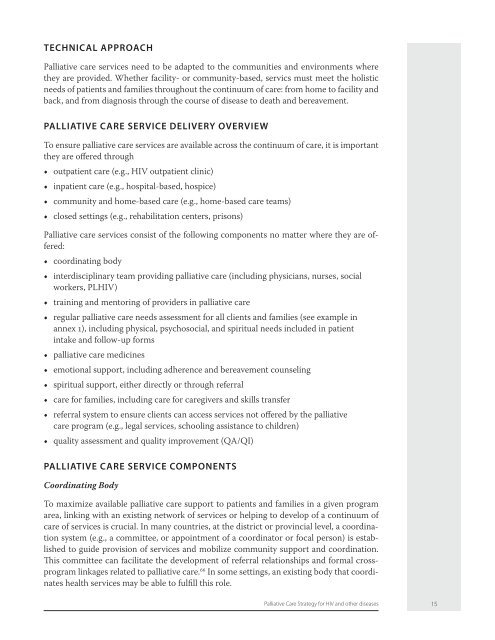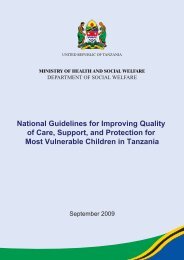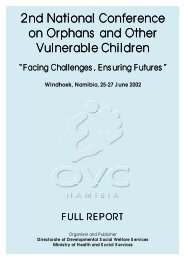Palliative Care Strategy for HIV and other diseases - FHI 360
Palliative Care Strategy for HIV and other diseases - FHI 360
Palliative Care Strategy for HIV and other diseases - FHI 360
You also want an ePaper? Increase the reach of your titles
YUMPU automatically turns print PDFs into web optimized ePapers that Google loves.
teChniCal approaCh<br />
<strong>Palliative</strong> care services need to be adapted to the communities <strong>and</strong> environments where<br />
they are provided. Whether facility- or community-based, servics must meet the holistic<br />
needs of patients <strong>and</strong> families throughout the continuum of care: from home to facility <strong>and</strong><br />
back, <strong>and</strong> from diagnosis through the course of disease to death <strong>and</strong> bereavement.<br />
palliative <strong>Care</strong> serviCe delivery overview<br />
To ensure palliative care services are available across the continuum of care, it is important<br />
they are offered through<br />
• outpatient care (e.g., <strong>HIV</strong> outpatient clinic)<br />
• inpatient care (e.g., hospital-based, hospice)<br />
• community <strong>and</strong> home-based care (e.g., home-based care teams)<br />
• closed settings (e.g., rehabilitation centers, prisons)<br />
<strong>Palliative</strong> care services consist of the following components no matter where they are offered:<br />
• coordinating body<br />
• interdisciplinary team providing palliative care (including physicians, nurses, social<br />
workers, PL<strong>HIV</strong>)<br />
• training <strong>and</strong> mentoring of providers in palliative care<br />
• regular palliative care needs assessment <strong>for</strong> all clients <strong>and</strong> families (see example in<br />
annex 1), including physical, psychosocial, <strong>and</strong> spiritual needs included in patient<br />
intake <strong>and</strong> follow-up <strong>for</strong>ms<br />
• palliative care medicines<br />
• emotional support, including adherence <strong>and</strong> bereavement counseling<br />
• spiritual support, either directly or through referral<br />
• care <strong>for</strong> families, including care <strong>for</strong> caregivers <strong>and</strong> skills transfer<br />
• referral system to ensure clients can access services not offered by the palliative<br />
care program (e.g., legal services, schooling assistance to children)<br />
• quality assessment <strong>and</strong> quality improvement (QA/QI)<br />
palliative <strong>Care</strong> serviCe Components<br />
Coordinating Body<br />
To maximize available palliative care support to patients <strong>and</strong> families in a given program<br />
area, linking with an existing network of services or helping to develop of a continuum of<br />
care of services is crucial. In many countries, at the district or provincial level, a coordination<br />
system (e.g., a committee, or appointment of a coordinator or focal person) is established<br />
to guide provision of services <strong>and</strong> mobilize community support <strong>and</strong> coordination.<br />
This committee can facilitate the development of referral relationships <strong>and</strong> <strong>for</strong>mal crossprogram<br />
linkages related to palliative care. 66 In some settings, an existing body that coordinates<br />
health services may be able to fulfill this role.<br />
<strong>Palliative</strong> <strong>Care</strong> <strong>Strategy</strong> <strong>for</strong> <strong>HIV</strong> <strong>and</strong> <strong>other</strong> <strong>diseases</strong><br />
15
















